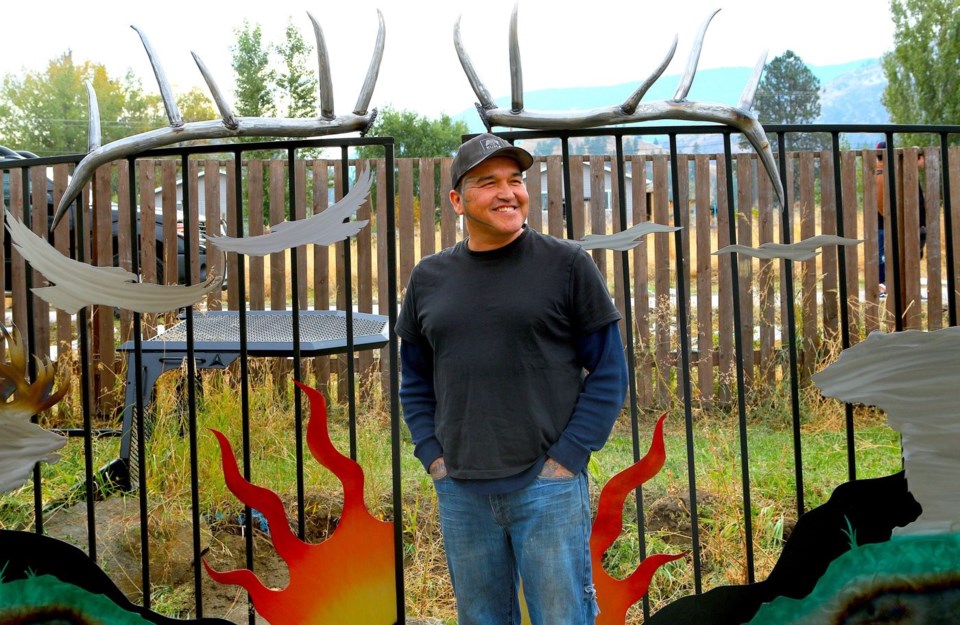When Clint George (wàpupxn) entered his first art competition at his elementary school in grade three, he didn’t think he could win.
“When I picked up a pencil and started drawing, I didn’t think I was ever going to make it on a pedestal, because for one, I’m First Nations, and I was also in grade three,” says George.
But he did win — his art was selected as first place out of the entire elementary school. That victory ignited hope in young George’s life, signally to him that he could do anything he put his mind to.
“I think at that point it was just, ‘Oh, we can do anything’ I mean, it’s a matter of how hard we push and how far we go,” he says.
He began welding when he was 11 and practiced many forms of visual art, from painting, to drawing, to sculpting. He then became a tattoo artist for eighteen years.
Now George, a member of Penticton Indian Band (PIB), is a PIB council member and full-time artist. For the past six years he has been building steel sculptures for many private collections, municipalities, and for First Nations schools across British Columbia.
His artwork is displayed as far as Japan, China, Russia and New Zealand.
“It’s an honour for me to be able to send out some of my stuff all around the world,” he says.
‘Proud to be Syilx’
One of George’s most recent sculptures is displayed in the Okanagan College, at the Kelowna Campus. The three story high sculpture shows steel images of the Okanagan/Syilx Nations Four-Food Chiefs, Saskatoon Berry, Bitter Root, Salmon, and Bear.
The Four-Food Chiefs are the cultural keystone species for the Okanagan/Syilx people, if they collapse that means their whole ecosystem will collapse. Each Chief represents the Okanagan/Syilx Peoples laws and these laws come from their C’aptikwl (oral stories), which show them how they should use their resources.
George says it’s important his sculptures are displayed in schools, where students go to learn. He wants to encourage students to learn the true history of Okanagan/Syilx people in their traditional stories embedded in his work.
“I think it’s very important to teach more of our images in our territory, who we are and where we are and come from,” says George whose Nsyilxcən (Syilx language) name wàpupxn, meaning linx, was given to him by his grandfather at birth.
“To be in the general public’s face and to say that, ‘we’re not going anywhere’ is important to me.”
The inspiration behind the artwork
George says his sculptures are inspired by his culture, traditions and traditional C’aptikwl.
George is currently building three sculptures for the City of Winfield, outside of Lake Country B.C.
The sculptures are made entirely of steel, both mounted on a hand-carved pole with pictographs engraved along the sides. He is also working on a fourteen-foot standing steel feather.
George says the steel canoe represents how Okanagan/Syilx people would fish, hunt and gather thousands of years ago in the Winfield area.
“It was a traditional place for us,” he explains.
George’s ‘Four-Food Chiefs’ sculpture is based on the Okanagan/Syilx Peoples’ creation story on who they are and how they became to be the people they are today.
“Those are the kinds of stories I hope it inspires people to want to know and learn more about,” George says.
George collaborated with Les Louise, another Indignenous artist from the Okanagan, to carve the poles and paint in the pictographs.
“There’s no letters, no words. It’s all images of pictographs telling the story of that area,” says George. “Which is actually another cool way of bringing knowledge to people about who we are and where we came from.”
George’s current installation of the three sculptures will be available to the public in late November, at the Pelmewash Parkway in Winfield.
“It makes me feel proud of who I am and where I’m from,” says George. “It makes me feel proud to be a Syilx person and to represent our people and our stories.”



